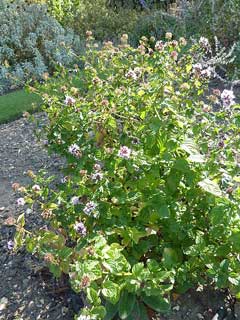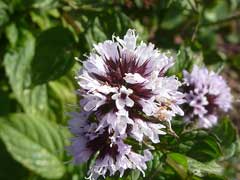 |
|
Mentha x piperita citrata |
 |
| http://commons.wikimedia.org/wiki/User:Magnus_Manske |
Translate this page:
Summary
Main Bloom Time: Late summer, Mid summer. Form: Spreading or horizontal.
Physical Characteristics

 Mentha x piperita citrata is a PERENNIAL growing to 0.3 m (1ft) by 1 m (3ft 3in) at a fast rate.
Mentha x piperita citrata is a PERENNIAL growing to 0.3 m (1ft) by 1 m (3ft 3in) at a fast rate.
See above for USDA hardiness. It is hardy to UK zone 3 and is not frost tender. It is in flower from August to October. The species is hermaphrodite (has both male and female organs) and is pollinated by Insects.
It is noted for attracting wildlife.
Suitable for: light (sandy), medium (loamy) and heavy (clay) soils and can grow in heavy clay soil. Suitable pH: mildly acid, neutral and basic (mildly alkaline) soils. It can grow in semi-shade (light woodland) or no shade. It prefers moist soil.
UK Hardiness Map
US Hardiness Map
Synonyms
M. aquatica citrata. M. citrata.
Plant Habitats
Woodland Garden Dappled Shade; Shady Edge; Cultivated Beds;
Edible Uses
Edible Parts: Leaves
Edible Uses: Condiment Tea
Leaves - raw or cooked. Used as a flavouring in salads or cooked foods[5]. A very pungent flavour, the leaves of the true eau-de-cologne mint are too aromatic for most tastes, though the cultivar 'Basil' has an excellent flavour and makes a very good substitute for basil in pesto[K]. A herb tea is made from the fresh or dried leaves[21, 183].
References More on Edible Uses
Medicinal Uses
Plants For A Future can not take any responsibility for any adverse effects from the use of plants. Always seek advice from a professional before using a plant medicinally.
Anodyne Antiseptic Antispasmodic Carminative Cholagogue Diaphoretic Refrigerant Stomachic
Tonic Vasodilator
Eau de Cologne mint, like many other members of this genus, is often used as a domestic herbal remedy, being valued especially for its antiseptic properties and its beneficial effect on the digestion. Like other members of the genus, it is best not used by pregnant women because large doses can cause an abortion. The leaves and flowering plant are anodyne, antiseptic, antispasmodic, carminative, cholagogue, diaphoretic, refrigerant, stomachic, tonic, vasodilator[4, 9, 21, 165]. A tea made from the leaves has traditionally been used in the treatment of fevers, headaches, digestive disorders and various minor ailments[222]. The medicinal uses of this herb are more akin to lavender (Lavandula spp) than the mints. It is used to treat infertility, rapid heartbeat, nervous exhaustion etc[238]. The leaves are harvested as the plant comes into flower and can be dried for later use[238]. The essential oil in the leaves is antiseptic, though it is toxic in large doses[222].
References More on Medicinal Uses
The Bookshop: Edible Plant Books
Our Latest books on Perennial Plants For Food Forests and Permaculture Gardens in paperback or digital formats.

Edible Tropical Plants
Food Forest Plants for Hotter Conditions: 250+ Plants For Tropical Food Forests & Permaculture Gardens.
More

Edible Temperate Plants
Plants for Your Food Forest: 500 Plants for Temperate Food Forests & Permaculture Gardens.
More

More Books
PFAF have eight books available in paperback and digital formats. Browse the shop for more information.
Shop Now
Other Uses
Essential Repellent Strewing
Landscape Uses: Container, Ground cover, Woodland garden. An essential oil obtained from the whole plant is a source of lavender oil which is used in perfumery[46, 105, 238]. It is also used in oral hygiene preparations, toiletries etc[238]. Formerly used as a strewing herb[14], the plant repels insects, rats etc[14, 18, 20]. Rats and mice intensely dislike the smell of mint. The plant was therefore used in homes as a strewing herb and has also been spread in granaries to keep the rodents off the grain[244]. Dynamic accumulator.
Special Uses
Attracts Wildlife Dynamic accumulator Food Forest Scented Plants
References More on Other Uses
Cultivation details
A very easily grown plant, it succeeds in most soils and situations so long as the soil is not too dry[1, 200]. Grows well in heavy clay soils. A sunny position is best for the production of essential oils, but the plant also succeeds in partial shade. Prefers a slightly acid soil[16]. Plants are very tolerant of neglect, succeeding in long grass[K]. Hybridizes freely with other members of this genus. Most mints have fairly aggressive spreading roots and, unless you have the space to let them roam, they need to be restrained by some means such as planting them in containers that are buried in the soil[K]. The flowers are very attractive to bees and butterflies[24]. A good companion for growing near cabbages and tomatoes, helping to keep them free of insect pests[14, 20]. The mint will need to be grown in containers to prevent it spreading too aggressively into the other plants. The whole plant has a strong minty aroma with a hint of ginger[245]. The plant produces a better quality essential oil if the plant is grown in dry ground[115]. Members of this genus are rarely if ever troubled by browsing deer[233]. Special Features:Attractive foliage, Edible, Fragrant foliage, Not North American native, Invasive, Naturalizing, Attracts butterflies, Suitable for cut flowers, Suitable for dried flowers. In garden design, as well as the above-ground architecture of a plant, root structure considerations help in choosing plants that work together for their optimal soil requirements including nutrients and water. The root pattern is rhizomatous with underground stems sending roots and shoots along their length [2-1].
References Carbon Farming Information and Carbon Sequestration Information
Temperature Converter
Type a value in the Celsius field to convert the value to Fahrenheit:
Fahrenheit:
The PFAF Bookshop
Plants For A Future have a number of books available in paperback and digital form. Book titles include Edible Plants, Edible Perennials, Edible Trees,Edible Shrubs, Woodland Gardening, and Temperate Food Forest Plants. Our new book is Food Forest Plants For Hotter Conditions (Tropical and Sub-Tropical).
Shop Now
Plant Propagation
Seed - sow spring in a cold frame. Germination is usually fairly quick. Prick out the seedlings into individual pots when they are large enough to handle and plant them out in the summer. Mentha species are very prone to hybridisation and so the seed cannot be relied on to breed true. Even without hybridisation, seedlings will not be uniform and so the content of medicinal oils etc will vary. When growing plants with a particular aroma it is best to propagate them by division[K]. Division can be easily carried out at almost any time of the year, though it is probably best done in the spring or autumn to allow the plant to establish more quickly. Virtually any part of the root is capable of growing into a new plant. Larger divisions can be planted out direct into their permanent positions. However, for maximum increase it is possible to divide the roots up into sections no more than 3cm long and pot these up in light shade in a cold frame. They will quickly become established and can be planted out in the summer.
Other Names
If available other names are mentioned here
Bergamot mint
Native Range
The hybrid formula is M. aquatica × M. spicata. Altay, Austria, Belgium, Bulgaria, Czechoslovakia, Denmark, France, Germany, Greece, Hungary, Iran, Italy, Kirgizstan, Lebanon-Syria, Netherlands, North Caucasus, Palestine, Poland, Romania, Sicilia, Switzerland, Turkey, Ukraine, Yugoslavia.
Weed Potential
Right plant wrong place. We are currently updating this section.
Please note that a plant may be invasive in one area but may not in your area so it's worth checking.
Conservation Status
IUCN Red List of Threatened Plants Status :

Growth: S = slow M = medium F = fast. Soil: L = light (sandy) M = medium H = heavy (clay). pH: A = acid N = neutral B = basic (alkaline). Shade: F = full shade S = semi-shade N = no shade. Moisture: D = dry M = Moist We = wet Wa = water.
Now available:
Food Forest Plants for Mediterranean Conditions
350+ Perennial Plants For Mediterranean and Drier Food Forests and Permaculture Gardens.
[Paperback and eBook]
This is the third in Plants For A Future's series of plant guides for food forests tailored to
specific climate zones. Following volumes on temperate and tropical ecosystems, this book focuses
on species suited to Mediterranean conditions—regions with hot, dry summers and cool, wet winters,
often facing the added challenge of climate change.
Read More
Expert comment
Author
(Ehrh.)Briq.
Botanical References
17200
Links / References
For a list of references used on this page please go here
Readers comment